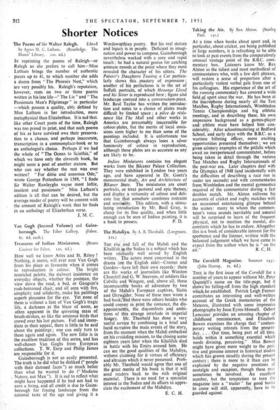Van Gogh (Second Volume) and Gains- borough. The Faber Gallery.
(Faber.
8s. 6d. each.)
How well we know Arles and St. Remy Nothing, it seems, will ever oust Van Gogh from his place as favourite when it comes to reproduction in colour. The bright restricted palette, the stalwart insistence on everyday objects, whether the postman, the view down the road, a bed, or Gauguin's rush-bottomed chair, and all seen with fire, simplicity and solidarity, make his paiitings superb pleasures for the eye. Yet none of them is without a hint of Van Gogh's tragic life, a darkness at the blaze of noon, so often apparent in the quivering mass of brush-strokes, so like the ominous birds that crowd over his last picture. Full and imme- diate in their appeal, there is little to be said about the paintings ; one can only turn to them again and again. The new folio is in the excellent tradition of this series, and has well-chosen Van Goghs from European collections. T. W. Earp and Philip James are responsible for it.
Gainsborough is not so easily presented. The truth is he did what he disliked (" people with their damned faces ") so much better than what he wanted to do (" Madame Nature, not Man "). It is sad to reflect what might have happened if he had not had to earn a living, and all credit is due to Gains- borough for freeing landscape from the rational taste of the age and giving it a Wordswcirthian poetry. But his real stature and legacy is in people. Deficient in imagi-
nation and power to compose, Gainsborough nevertheless worked with a sure and rapid touch ; he had a natural genius for catching animate moods at the point where they most revealed the character of his sitters. The Painter's Daughters Teasing a Cat particu- larly shows this ,mastery of expression ; another of his perfections is in the set of Suffolk portraits, of which Heneage Lloyd and'his Sister is reproduced here ; figure and landscape coerced into a conversation-piece. Mr. Basil Taylor has written the introduc- tion and notes to a choice of plates made difficult by limited space ; a piece de resis- tance like The Mall and other works in America are presumably inaccessible for colour-plates, but the merits of local omis- sions seem higher to me than some of the paintings included. It is unfortunate too that Gainsborough always loses a silver luminosity of colour in reproduction, although these plates are as accurate as any are likely to be.- Indian Miniatures contains ten elegant works from the Bikaner Palace Collection. They were exhibited in London two years ago, and have appeared in Dr. Goetz's monumental study, Art and Architecture of Bikaner State. The miniatures are court portraits, or treat pastoral and epic themes,, and display ,a virtuosity of colour and deli- cate line that somehow combines restraint and sensiality. This edition, with a stimu- lating introduction by Mr. Basil Gray, is cheap for its fine quality, and when little enough can be seen of Indian painting, it is


































 Previous page
Previous page